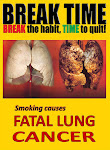
A study published online in the Journal of Public Health found that while it is important to ban misleading health descriptors such as ‘light’, ‘low-tar’, and ‘mild’, it is also important to ban other tactics used to undermine the impact of the elimination of these terms. For example, the study demonstrates that the industry has used descriptions of taste, such as ‘smooth’ and ‘full flavor’, and elements of package design (e.g. color-coding) on cigarettes formerly labeled ‘light’, ‘mild’ or ‘low tar’ to continue to mislead consumers.
The study was conducted in Ontario, Canada, where tobacco companies were court-ordered to stop using misleading descriptors by August 2007. More than 600 smokers and non-smokers were asked about their perceptions of packs with varying terms, colors, and design.
Study Findings
• Respondents were more likely to rate packages with the terms ‘light’, ‘mild’, ‘smooth’ and ‘silver’ as delivering less tar and having lower health risk compared with ‘regular’ and ‘full flavor’ brands.
• Respondents rated packages with lighter colors and a picture of a filter as significantly more likely to deliver less tar and lower health risk.
Conclusion
• Perceptions of risk and tar delivery are strongly associated with package design elements such as other descriptors, tar levels, and colors.
• Current regulations banning misleading terms have failed to remove misleading information from tobacco packaging due to the industry’s use of other package design elements.
Key Messages
• Laws regarding misleading information should encompass misleading design innovations by the tobacco industry.
• Laws regarding misleading descriptors should give a governmental agency the authority to adopt new rules to quickly address innovative ways the tobacco manufacturers adopt to continue to mislead consumers.
• Enforcement of the law should include all aspects of package design that may mislead consumers such as other descriptors, colors, and tar levels.
Full study available in English from:
http://jpubhealth. oxfordjournals. org/cgi/reprint/ fdp066v1
The study was conducted in Ontario, Canada, where tobacco companies were court-ordered to stop using misleading descriptors by August 2007. More than 600 smokers and non-smokers were asked about their perceptions of packs with varying terms, colors, and design.
Study Findings
• Respondents were more likely to rate packages with the terms ‘light’, ‘mild’, ‘smooth’ and ‘silver’ as delivering less tar and having lower health risk compared with ‘regular’ and ‘full flavor’ brands.
• Respondents rated packages with lighter colors and a picture of a filter as significantly more likely to deliver less tar and lower health risk.
Conclusion
• Perceptions of risk and tar delivery are strongly associated with package design elements such as other descriptors, tar levels, and colors.
• Current regulations banning misleading terms have failed to remove misleading information from tobacco packaging due to the industry’s use of other package design elements.
Key Messages
• Laws regarding misleading information should encompass misleading design innovations by the tobacco industry.
• Laws regarding misleading descriptors should give a governmental agency the authority to adopt new rules to quickly address innovative ways the tobacco manufacturers adopt to continue to mislead consumers.
• Enforcement of the law should include all aspects of package design that may mislead consumers such as other descriptors, colors, and tar levels.
Full study available in English from:
http://jpubhealth. oxfordjournals. org/cgi/reprint/ fdp066v1







